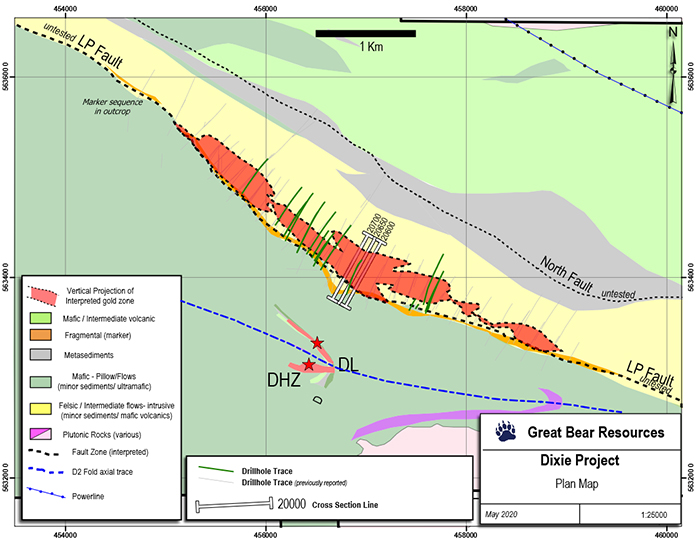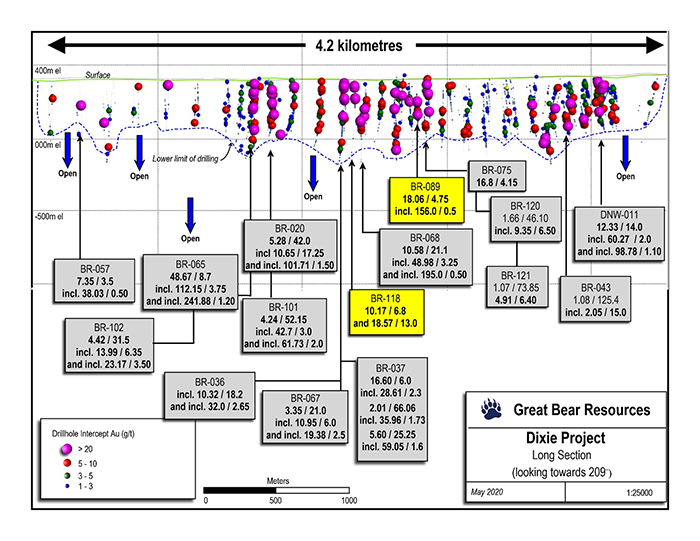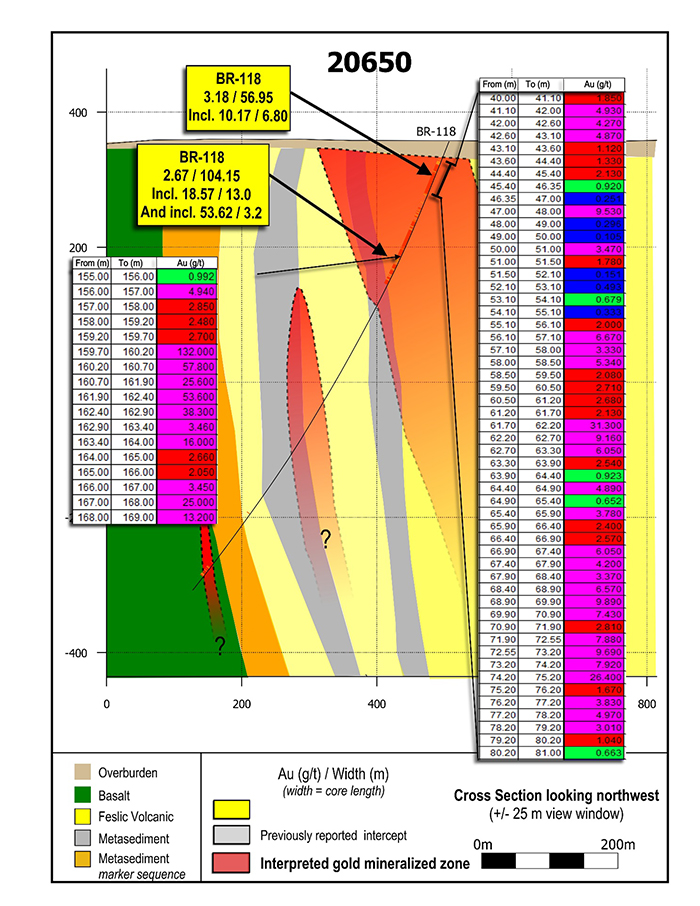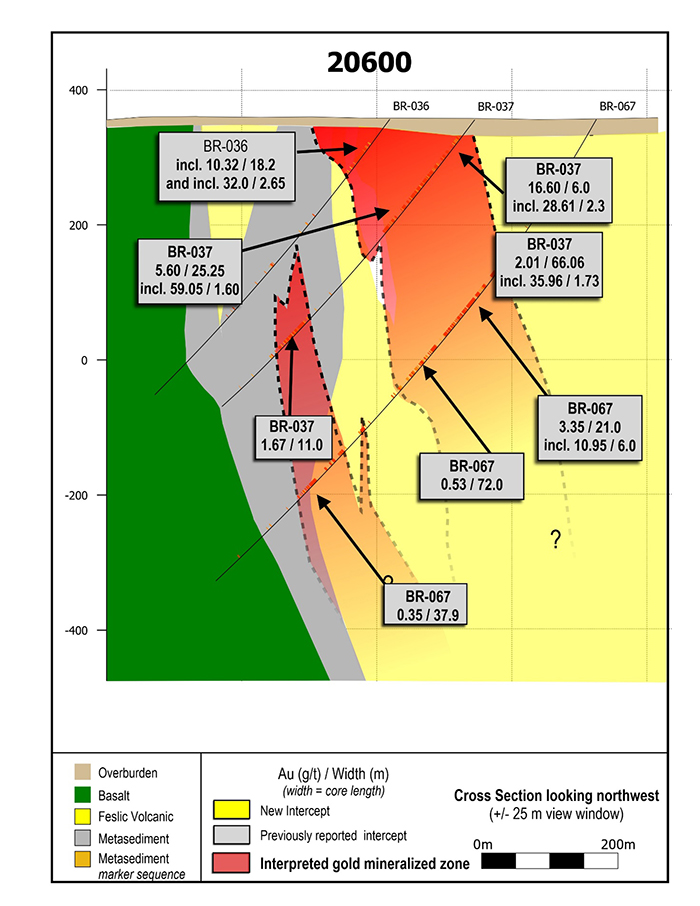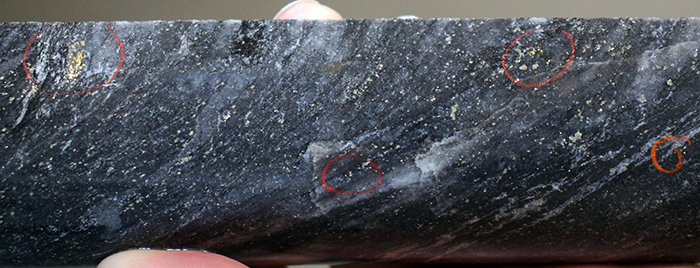Great Bear Drills 18.57 g/t Gold Over 13.00 m, Within 2.67 g/t Gold Over 104.15 m at LP Fault
May 4, 2020 – Vancouver, British Columbia, Canada – Great Bear Resources Ltd. (the "Company" or "Great Bear", TSX-V: GBR; OTCQX: GTBDF) today reported results from its ongoing fully funded $21 million exploration program at its 100% owned flagship Dixie Project in the Red Lake district of Ontario.
Chris Taylor, President and CEO of Great Bear said, “As we approach the one-year anniversary of the discovery of the LP Fault and our 100th drill hole into this target, our sense of enthusiasm continues to build as the LP Fault continues to deliver robust gold results with more detailed drilling. New drill hole BR-118 returned one of the longest high-grade gold intervals to-date, and was completed in the middle of a 150 metre gap in drilling. Mineralization begins immediately at the bedrock surface, with consistent geology and mineralization styles observed in both neighbouring drill sections. Importantly, all other drill holes reported in this release also continue to successfully intersect gold mineralization at all points tested along the LP Fault to-date.”
The Company has completed 99 of approximately 300 planned drill holes into the LP Fault target, as part of its 5 kilometre long by 500 metre deep grid drill program. Current drill hole locations and results are provided in Figure 1, and in Table 1, respectively. An updated long section of the LP Fault drilling is provided in Figure 2.
Drill Results Highlights:
- Drill hole BR-118 on drill section 20650 was completed in the middle of a 150 metre gap in drilling. The drill hole contained two significant mineralized intervals:
- 10.17 g/t gold over 6.80 metres, within a broader interval of 3.18 g/t gold over 56.95 metres, beginning at the bedrock surface at 30.20 metres, and
- 18.57 g/t gold over 13.00 metres, including 132.00 g/t gold over 0.50 metres, within a broader interval of 2.67 g/t over 104.15 metres beginning at 127.15 metres. Figure 3. An image of gold mineralization from this highlight interval is also provided in Figure 6.
- Continuity of gold mineralization is suggested by similar results on both adjacent drill sections:
- Drill section 20750, located 75 - 100 metres to the northwest of BR-118, includes previously reported drill hole BR-068 which returned 10.58 g/t gold over 21.10 metres (February 13, 2020). Figure 4.
- Drill section 20600, located 50 - 75 metres to the southeast of BR-118, includes previously reported drill hole BR-037 which returned 16.60 g/t gold over 6.0 metres, and 5.60 g/t gold over 25.25 metres (October 30, 2019). Figure 5.
- Other new drill highlights include drill hole BR-089 on section 21100, located 450 metres northwest of BR-118. Assays include 18.06 g/t gold over 4.75 metres, which includes 156.00 g/t gold over 0.50 metres, and 11.03 g/t gold over 6.95 metres, which includes 112.00 g/t gold over 0.5 metres. This occurs within a broader interval of 1.93 g/t gold over 52.15 metres.
- Drill hole BR-088 on section 22000, located 900 metres to the northwest of BR-089 and 1.35 kilometres to the northwest of BR-118, intersected 0.71 g/t gold over 100.95 metres.
- The Company also relogged and assayed historical drill hole DC-13-07, which was completed in 2007 in the immediate footwall south of the LP Fault by a previous explorer. New assays include 7.87 g/t gold over 2.00 metres, collected from un-sampled, mineralized historic drill core.
Figure 1: Location of drill sections provided as figures in this release.
Table 1: Current drill results. Drill sections are arranged from southeast (top of Table) to northwest (bottom of Table), corresponding to the map provided in Figure 1.
| Drill Hole | From (m) | To (m) | Width* (m) | Gold (g/t) | Section | |
| BR-105 | 175.00 | 179.50 | 4.50 | 1.35 | 19900 | |
| and | 341.65 | 344.90 | 3.25 | 1.05 | ||
| BR-106 | 318.00 | 321.00 | 3.00 | 0.83 | 19900 | |
| and | 427.15 | 429.50 | 2.35 | 0.61 | ||
| BR-104 | 65.00 | 69.00 | 4.00 | 1.15 | 19900 | |
| and | 77.85 | 83.00 | 5.15 | 1.30 | ||
| and | 228.00 | 240.10 | 12.10 | 0.67 | ||
| DC-13-07 | 24.95 | 26.00 | 1.05 | 1.10 | 19950 | |
| and | 105.00 | 107.00 | 2.00 | 7.87 | ||
| including | 106.00 | 107.00 | 1.00 | 12.60 | ||
| DC-14-07 | 92.00 | 93.00 | 1.00 | 0.17 | 19950 | |
| BR-103 | 392.25 | 396.25 | 4.00 | 0.20 | 19950 | |
| and | 417.50 | 442.00 | 24.50 | 0.23 | ||
| and | 463.50 | 464.50 | 1.00 | 1.77 | ||
| and | 517.75 | 536.25 | 18.50 | 0.87 | ||
| including | 523.50 | 527.00 | 3.50 | 2.93 | ||
| and including | 526.50 | 527.00 | 0.50 | 16.90 | ||
| and | 612.00 | 624.50 | 12.50 | 0.37 | ||
| BR-118 | 30.20 | 87.15 | 56.95 | 3.18 | 20650 | |
| including | 40.00 | 80.20 | 40.20 | 4.42 | ||
| and including | 55.10 | 79.20 | 24.10 | 6.00 | ||
| and including | 61.70 | 63.30 | 1.60 | 14.91 | ||
| and including | 68.40 | 75.20 | 6.80 | 10.17 | ||
| and | 127.15 | 231.30 | 104.15 | 2.67 | ||
| including | 156.00 | 184.90 | 28.90 | 8.75 | ||
| and including | 156.00 | 169.00 | 13.00 | 18.57 | ||
| and including | 159.70 | 169.00 | 9.30 | 24.65 | ||
| and including | 159.70 | 162.90 | 3.20 | 53.62 | ||
| and including | 159.70 | 160.70 | 1.00 | 94.90 | ||
| and including | 159.70 | 160.20 | 0.50 | 132.00 | ||
| BR-122 | 446.00 | 488.00 | 42.00 | 0.34 | 20950 | |
| BR-130 | 165.00 | 167.50 | 2.50 | 2.09 | 21000 | |
| and | 190.25 | 219.00 | 28.75 | 0.33 | ||
| BR-131 | 167.00 | 169.70 | 2.70 | 5.29 | 21000 | |
| including | 168.00 | 169.20 | 1.20 | 11.70 | ||
| and | 183.00 | 187.85 | 4.85 | 5.09 | ||
| including | 186.50 | 187.85 | 1.35 | 18.02 | ||
| and including | 186.50 | 187.00 | 0.50 | 47.70 | ||
| and | 324.00 | 366.30 | 42.30 | 0.51 |
Table 1 is continued below.
| Drill Hole | From (m) | To (m) | Width* (m) | Gold (g/t) | Section | |
| BR-089 | 172.55 | 182.00 | 9.45 | 8.15 | 21100 | |
| including | 172.55 | 179.50 | 6.95 | 11.03 | ||
| including | 172.55 | 175.05 | 2.50 | 7.81 | ||
| and including | 177.50 | 178.00 | 0.50 | 112.00 | ||
| and | 190.50 | 191.50 | 1.00 | 2.86 | ||
| including | 191.00 | 191.50 | 0.50 | 5.59 | ||
| and | 225.25 | 228.00 | 2.75 | 1.51 | ||
| 242.00 | 293.25 | 51.25 | 1.93 | |||
| including | 279.00 | 293.25 | 14.25 | 6.18 | ||
| and including | 282.50 | 287.25 | 4.75 | 18.06 | ||
| And including | 282.50 | 285.65 | 3.15 | 26.89 | ||
| and including | 283.65 | 284.15 | 0.50 | 156.00 | ||
| BR-099 | 118.20 | 138.50 | 20.30 | 0.34 | 21300 | |
| and | 291.00 | 292.00 | 1.00 | 4.68 | ||
| and | 301.50 | 322.50 | 21.00 | 0.42 | ||
| including | 315.00 | 315.50 | 0.50 | 5.46 | ||
| and | 446.80 | 456.00 | 9.20 | 2.40 | ||
| including | 454.50 | 456.00 | 1.50 | 12.10 | ||
| BR-116 | 288.25 | 294.25 | 6.00 | 0.50 | 21400 | |
| and | 466.60 | 496.00 | 29.40 | 0.39 | ||
| including | 492.35 | 494.15 | 1.80 | 3.36 | ||
| and | 509.00 | 513.70 | 4.70 | 1.38 | ||
| and | 523.35 | 532.70 | 9.35 | 1.10 | ||
| including | 527.60 | 528.70 | 1.10 | 7.77 | ||
| BR-097 | 40.60 | 45.00 | 4.40 | 0.15 | 21400 | |
| and | 255.00 | 259.00 | 4.00 | 1.39 | ||
| and | 391.70 | 393.50 | 1.80 | 3.49 | ||
| BR-098 | 148.50 | 153.50 | 5.00 | 0.69 | 21400 | |
| and | 310.15 | 311.65 | 1.50 | 1.05 | ||
| and | 376.85 | 396.50 | 19.65 | 0.28 | ||
| and | 419.70 | 448.50 | 28.80 | 0.65 | ||
| including | 431.25 | 438.00 | 6.75 | 2.24 | ||
| and including | 431.25 | 432.65 | 1.40 | 8.93 | ||
| and | 493.25 | 495.05 | 1.80 | 9.90 | ||
| BR-115 | 428.55 | 431.00 | 2.45 | 0.53 | 21525 | |
| and | 481.80 | 502.40 | 20.60 | 0.43 | ||
| and | 527.80 | 562.65 | 34.85 | 0.20 | ||
| BR-088 | 172.50 | 174.00 | 1.50 | 0.70 | 22000 | |
| and | 357.00 | 366.00 | 9.00 | 0.97 | ||
| and | 375.35 | 383.50 | 8.15 | 0.74 | ||
| and | 449.30 | 450.45 | 1.15 | 3.38 | ||
| and | 515.55 | 616.50 | 100.95 | 0.71 | ||
| including | 515.55 | 527.00 | 11.45 | 1.38 | ||
| and including | 549.95 | 557.45 | 7.50 | 1.12 | ||
| and including | 606.30 | 616.50 | 10.20 | 1.80 |
*Widths are drill indicated core length, as insufficient drilling has been undertaken to determine true widths at this time. Average grades are calculated with un-capped gold assays, as insufficient drilling has been completed to determine capping levels for higher grade gold intercepts. Average widths are calculated using a 0.10 g/t gold cut-off grade with up to 3 m of internal dilution of zero grade. Drill holes DC-13-07 and DC-14-07 were originally drilled by a past explorer but were assayed by Great Bear, and are located in the immediate footwall south of the LP Fault zone.
Figure 2: Updated long section of the central LP Fault drilling. Additional drilling has also been completed along more than 6 kilometres of additional strike length to the southeast (left) of this image. The locations of drill sections highlighted in this release are labelled.
Complete assays for the highlighted reported intervals in hole BR-118 are also included graphically within section 20650 in Figure 3 below.
Approximately 200 drill holes remain to be completed as part of the Company’s ongoing 2020 LP Fault drill program. Additional drill holes are also planned into the Dixie Limb and Hinge zones, in additional to other regional targets. The Company remains fully funded for this work and does not anticipate requiring further financing in 2020.
Figure 3: Cross section 20650. Apparent continuity of mineralization along 150 metres of strike length of the LP Fault can be compared in Figure 3, 4 and 5. Mineralization remains open to extension in all directions.
Figure 4: Section 20750. This section is located 75 – 100 metres northwest along strike of section 20650 in Figure 3 and shows apparent on-strike continuation of mineralization with BR-118. It was originally disclosed on February 13, 2020.
Figure 5: Section 20600. This section is located 50 - 75 metres southeast along strike of section 20650 in Figure 3 and shows apparent on-strike continuation of mineralization with BR-118. It was originally disclosed on October 30, 2019.
Figure 6: Image of gold mineralization from LP Fault drill hole BR-118. Mineralization depicted in this image is from a selective interval and is not necessarily indicative of mineralization on the property.
Updated drill collar locations, azimuths and dips, together with an updated complete assay table for the LP Fault drilling to-date will be posted to the Company’s web site at www.greatbearresources.ca. Drill collar locations, azimuths and dips for the drill holes included in this release are provided in the table below:
| Hole ID | Easting | Northing | Elevation | Depth | Dip | Azimuth |
| BR-088 | 455986 | 5635191 | 374 | 762 | -63 | 225 |
| BR-089 | 456591 | 5634475 | 358 | 717 | -68 | 214 |
| BR-097 | 456314 | 5634687 | 362 | 537 | -60 | 220 |
| BR-098 | 456371 | 5634762 | 364 | 681 | -60 | 220 |
| BR-099 | 456482 | 5634659 | 363 | 642 | -55 | 220 |
| BR-103 | 457736 | 5634241 | 364 | 810 | -60 | 210 |
| BR-104 | 457647 | 5633886 | 318 | 366 | -53 | 206 |
| BR-105 | 457691 | 5633975 | 357 | 500 | -55 | 207 |
| BR-106 | 457738 | 5634071 | 356 | 624 | -57 | 207 |
| BR-115 | 456325 | 5634908 | 371 | 741 | -59 | 220 |
| BR-116 | 456436 | 5634848 | 367 | 792 | -60 | 220 |
| BR-117 | 456554 | 5634762 | 364 | 798 | -55 | 220 |
| BR-118 | 456923 | 5634183 | 356 | 771 | -68 | 222 |
| BR-122 | 456815 | 5634528 | 357 | 777 | -54 | 215 |
| BR-130 | 456593 | 5634373 | 358 | 481 | -55 | 215 |
| BR-131 | 456648 | 5634454 | 357 | 648 | -60 | 218 |
| DC-13-07 | 457456 | 5633794 | 361 | 200 | -50 | 210 |
| DC-14-07 | 457489 | 5633740 | 360 | 116 | -60 | 210 |
Completion of Plan of Arrangement
The Company is pleased to announce that it has received Final TSX Venture Exchange (“TSX-V”) approval of the previously announced plan of arrangement (“Arrangement”) to reorganize its business, including the spin-off of its wholly-owned subsidiary, Great Bear Royalties Corp. The Arrangement is expected to close as of 12:01 a.m. on May 5, 2020. Existing common shares of Great Bear are expected to be delisted on the TSX-V effective on the close of business on May 4, 2020. New common shares of Great Bear are expected to commence trading on the TSX-V at the market opening on May 5, 2020.
About the Dixie Project
The Dixie Project is 100% owned, comprised of 9,140 hectares of contiguous claims that extend over 22 kilometres, and is located approximately 25 kilometres southeast of the town of Red Lake, Ontario. The project is accessible year-round via a 15 minute drive on a paved highway which runs the length of the northern claim boundary and a network of well-maintained logging roads.
The Dixie Project hosts two principle styles of gold mineralization:
- High-grade gold in quartz veins and silica-sulphide replacement zones (Dixie Limb and Hinge). Hosted by mafic volcanic rocks, and localized near regional-scale D2 fold axes. These mineralization styles are also typical of the significant mined deposits of the Red Lake district.
- High-grade disseminated gold with broad moderate to lower grade envelopes (LP Fault). The LP Fault is a significant gold-hosting structure which has been seismically imaged to extend to 14 kilometres depth (Zeng and Calvert, 2006), and has been interpreted by Great Bear to have up to 18 kilometres of strike length on the Dixie property. High-grade gold mineralization is controlled by structural and geological contacts, and moderate to lower-grade disseminated gold surrounds and flanks the high-grade intervals. The dominant gold-hosting stratigraphy consists of felsic sediments and volcanic units.
About Great Bear
Great Bear Resources Ltd. is a well-financed gold exploration company managed by a team with a track record of success in mineral exploration. Great Bear is focused in the prolific Red Lake gold district in northwest Ontario, where the company controls over 300 km2 of highly prospective tenure across 4 projects: the flagship Dixie Project (100% owned), the Pakwash Property (earning a 100% interest), the Dedee Property (earning a 100% interest), and the Sobel Property (earning a 100% interest), all of which are accessible year-round through existing roads.
QA/QC and Core Sampling Protocols
Drill core is logged and sampled in a secure core storage facility located in Red Lake Ontario. Core samples from the program are cut in half, using a diamond cutting saw, and are sent to Activation Laboratories in Ontario, an accredited mineral analysis laboratory, for analysis. All samples are analysed for gold using standard Fire Assay-AA techniques. Samples returning over 10.0 g/t gold are analysed utilizing standard Fire Assay-Gravimetric methods. Pulps from approximately 5% of the gold mineralized samples are submitted for check analysis to a second lab. Selected samples are also chosen for duplicate assay from the coarse reject of the original sample. Selected samples with visible gold are also analyzed with a standard 1 kg metallic screen fire assay. Certified gold reference standards, blanks and field duplicates are routinely inserted into the sample stream, as part of Great Bear’s quality control/quality assurance program (QAQC). No QAQC issues were noted with the results reported herein.
Qualified Person and NI 43-101 Disclosure
Mr. R. Bob Singh, P.Geo, Director and VP Exploration, and Ms. Andrea Diakow P.Geo, Exploration Manager for Great Bear are the Qualified Persons as defined by National Instrument 43-101 responsible for the accuracy of technical information contained in this news release.
ON BEHALF OF THE BOARD
“Chris Taylor”
Chris Taylor, President and CEO
Investor Inquiries:
Mr. Knox Henderson
Office: 604-646-8354
Direct: 604-551-2360
info@greatbearresources.ca
www.greatbearresources.ca
Cautionary note regarding forward-looking statements
This release contains certain “forward looking statements” and certain “forward-looking information” as defined under applicable Canadian and U.S. securities laws. Forward-looking statements and information can generally be identified by the use of forward-looking terminology such as “may”, “will”, “should”, “expect”, “intend”, “estimate”, “anticipate”, “believe”, “continue”, “plans” or similar terminology. The forward-looking information contained herein is provided for the purpose of assisting readers in understanding management’s current expectations and plans relating to the future. Readers are cautioned that such information may not be appropriate for other purposes.
Forward-looking information are based on management of the parties’ reasonable assumptions, estimates, expectations, analyses and opinions, which are based on such management’s experience and perception of trends, current conditions and expected developments, and other factors that management believes are relevant and reasonable in the circumstances, but which may prove to be incorrect.
Great Bear undertakes no obligation to update forward-looking information except as required by applicable law. Such forward-looking information represents management's best judgment based on information currently available. No forward-looking statement can be guaranteed and actual future results may vary materially. Accordingly, readers are advised not to place gundue reliance on forward-looking statements or information.


